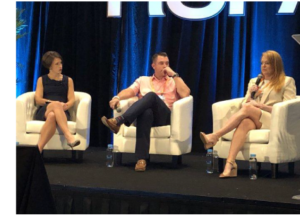By: Jim Roddy, VP of Marketing at the RSPA
I’m waiting for someone in our channel to be so bold they submit a presentation for RetailNOW titled “Marketing: You’re Doing It Wrong.” That might sound impolite, but it would accurately depict many in our industry who fail to follow the principles and practices detailed by Seth Godin in Permission Marketing: Turning Strangers into Friends and Friends into Customers.
Peruse some of my favorite quotes and concepts from the book below, and I guarantee you’ll shake your head a few times about where you’re falling short:
- Anticipated, personal, and relevant messages delivered to people who want to get them is the core of marketing for the foreseeable future.
- For 90 years marketers have relied on one form of advertising almost exclusively. I call it Interruption Marketing. The key to each and every ad is to interrupt what the viewers are doing in order to get them to think about something else.
- As clutter has increased, advertisers have responded by increasing clutter.
- Permission Marketing offers the consumer an opportunity to volunteer to be marketed to. Permission Marketing allows marketers to tell their story calmly and to succinctly, without fear of being interrupted by competitors or Interruption Marketers. It serves both consumers and marketers in a symbiotic exchange.
- Permission Marketing is anticipated, personal, and relevant. Anticipated: people look forward to hearing from you. Personal: the messages are directly related to the individual. Relevant: the marketing is about something the prospect is interested in.
- The incentive you offer the customer can range from information, to entertainment, to sweepstakes, to outright payment for the prospect’s attention. But the incentive must be overt, obvious, and clearly delivered.
- Interruption Marketers spend all their time interrupting strangers in an almost pitiful attempt to bolster popularity and capture attention.
- The Permission Marketer offers a curriculum over time, teaching the consumer about the product or service he has to offer. Every step along the way has to be interesting, useful, and relevant.
- Permission Marketing requires patience.
- In 1908, when Proctor & Gamble introduced Crisco, they also introduced a series of free cookbooks. In a classic Permission Marketing technique, P&G didn’t try to sell the product. Instead they promoted the free cookbook. The cookbook taught the consumer about the benefits of the product.
- The process of getting new customers needs to be re-engineered. Like caterpillars turn into butterflies, prospects go through a five-step cycle: Strangers, Friends, Customers, Loyal Customers, Former Customers.
- A suite of marketing messages must teach, cajole, and encourage the stranger to become a friend. And once she becomes a friend, to apply enough focused marketing to create a customer.
- Technology enables marketers to have a perfect memory and provides them with the ability to customize correspondence on the fly and deliver it for free via email.
- Frequency builds trust. Trust is not an event. It’s a step-by-step process that requires time and money and commitment.
- Once you know that the vast majority of people you target want to hear from you, frequency starts looking pretty attractive. And when you can use the power of the new media to deliver that frequency for free, you hit a home run.
- Great brand marketers know how to gently leverage and even build brand trust. Shortsighted ones, however, can burn it down with amazing haste.
RSPA Recommended Read Rating: 9.9/10
Instead of wagging my finger in your face preaching how you need to repent for your marketing misdeeds, let me bring the book to life by sharing how Permission Marketing has changed how the RSPA engages with prospects and members. The primary outcomes we’re trying to achieve through our messaging are (1) join the association, (2) engage with our services, and (3) register for our events – RetailNOW and Inspire. Additionally, we want our VAR and ISV members to (4) support the sponsors who financially back the association.
We could send a couple emails asking contacts to take these actions. When our results aren’t achieved, we could double the frequency of our email sends. When that proved futile, we could triple the email frequency. That, of course, would work about as well as a vendor grabbing a VAR by the lapels at a cocktail party in an attempt to convince them to join their new channel program.
When RSPA Marketing Communications Manager Chris Arnold and I reviewed the year-to-date RSPA email schedule after RetailNOW 2019, we counted a high number of action-oriented messages (register for this!) and sponsor-focused messages (read this ad!) and few messages solely intended to provide business guidance or industry insights to the reader. Nearly 4-out-of-5 RSPA emails were interruptions and likely viewed as clutter in many recipients’ inbox.
The RSPA email that provided the most value was our monthly Community Connection newsletter. It linked to RSPA Blog posts (educational content and analysis by the RSPA staff), the  RSPA Community IQ resource center (educational content created by members), insights from Legal Counsel Bob Goldberg and RSPA CEO John Kirk, and a list of upcoming industry events. Chris then pulled Constant Contact reports that showed overall RSPA email open rates and click rates were declining while unsubscribes were up. Additionally, anecdotal evidence showed we never received a VAR or ISV member complaint about the RSPA newsletter but we heard several unfavorable comments about Sponsor Spotlight emails.
RSPA Community IQ resource center (educational content created by members), insights from Legal Counsel Bob Goldberg and RSPA CEO John Kirk, and a list of upcoming industry events. Chris then pulled Constant Contact reports that showed overall RSPA email open rates and click rates were declining while unsubscribes were up. Additionally, anecdotal evidence showed we never received a VAR or ISV member complaint about the RSPA newsletter but we heard several unfavorable comments about Sponsor Spotlight emails.
Determined to follow Godin’s Permission Marketing guidelines, our team huddled and for 2020 we decided to:
- Discontinue Sponsor Spotlight emails
- Increase the frequency of the Community Connection newsletter from monthly to 3x/month
- Integrate sponsored content into our newsletter
- Build a system to generate more Community IQ content
- Publish at least three blog posts each month
- Launch at least two podcasts each month
- Reach out to members who had unsubscribed to share our new content plan and ask them to give us permission to re-subscribe them
- Keep the same frequency of event-focused emails, but center messaging on VAR and ISV benefits
Those emails would be sent en masse to our master list of resellers, software developers, vendors, and distributors through Constant Contact. Meanwhile, I would continue to email RSPA Blog content to my personal list of channel connections through Outlook using Word’s mail merge function. For several years, I have maintained and expanded a database that includes the first name, last name, and email address of individuals in our channel I have crossed paths with. Once or twice a month for nearly half a decade, I’ve emailed them links to my latest blog posts, podcasts, and other content I think they would find interesting.
Statistics and anecdotes show this Permission Marketing-like effort works:
- My list has grown to include 1,404 active executives and staff members at channel companies, and over the past 12 months I’ve received only 28 unsubscribe requests (1.99%). That means 98.1% of that giant, targeted list has given me permission to reach out to them 18-24 times a year.
- When I send my introductory email informing an individual I’ve added them to my blog distribution list and giving them the opportunity to opt out, I have yet to receive one rejection. In fact, the most common responses are “Thank you so much!” and “Can you please add these colleagues of mine to your list?”
- I send these emails early in the morning because I know my audience, especially VARs and ISVs, can get pulled away from their computers to serve their merchants during the day. On those email-send days, I make sure not to pack my own schedule because inevitably the outreach will result in several recipients asking me a question or making an RSPA-related request.
- Some on my distribution list haven’t replied to a prior email message I’ve sent trying to schedule a meeting with them. But the blog email acts as a friendly tap on their shoulder, and many of them eventually reply to engage more with the RSPA.
- When individuals switch companies, they will send me their new email address and ask to remain on my list.
The response to our new Godin-like efforts has been positive. Inspire 2020 set an attendance record for RSPA conferences in the Caribbean and was a whisper behind the all-time Inspire mark for reseller attendees. A LinkedIn post featuring highlights from the Inspire leadership panel (no promotional content) has over 3,700 views and 60+ Likes. In the past six months, RSPA has launched 32 Community IQ articles (5.33/month), a significant uptick from the nine published during the first seven months of 2019 (1.25/month). Our RSPA Trusted Advisor podcast/video interview series, merely an idea six months ago, recently topped 1,000 downloads and views.
For your organization and mine, more engagement leads to higher customer retention. More engagement produces greater attention from prospects. But before that engagement comes permission. Start on your engagement journey today by ordering Permission Marketing here, and then developing your plan to deliver anticipated, personal, and relevant messages to your clients and prospects. And you don’t have to walk this path alone. The RSPA offers VAR/ISV Business Advisory Services, including marketing guidance, which is included with your association membership.
Keep in mind Godin’s advice that trust is “a step-by-step process that requires time and money and commitment.” Carve out time in your schedule to implement a Permission Marketing strategy throughout 2020. Your target audience will reward you for it.
Special thanks to CBS NorthStar COO and RSPA board member Jeremy Julian for recommending Permission Marketing to Chris and me.




